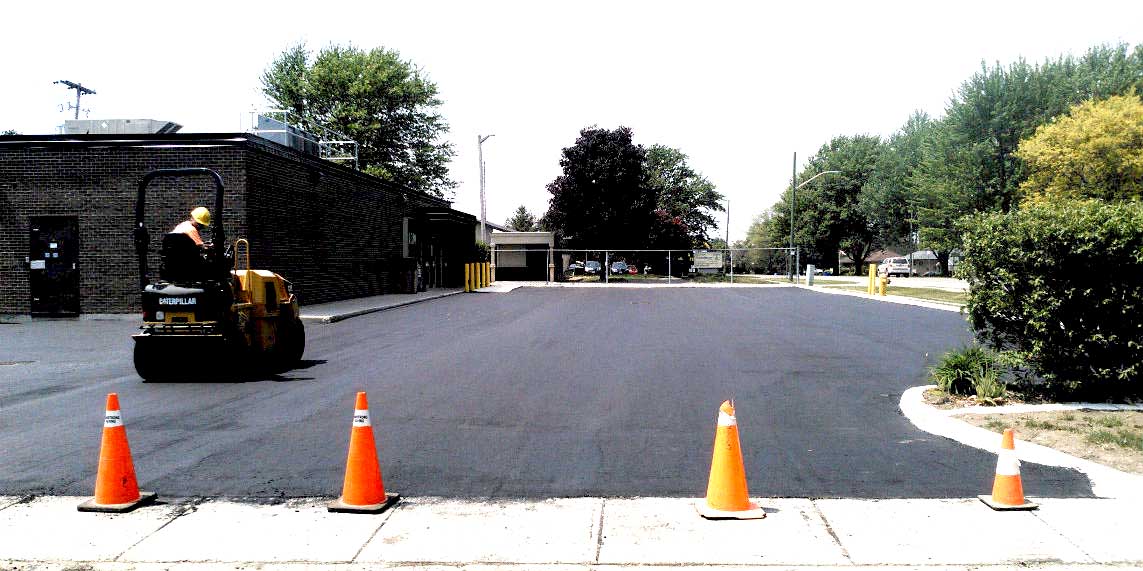
Parking lot construction is an expensive undertaking. Once that investment has been made the parking lot still needs to be maintained. There are several reasons to keep the area well maintained including the appearance of the lot and the image that it projects upon your company. A well-maintained lot also provides safe access to your facilities for your customers, suppliers and employees thus reducing your liability risks as well as reducing future maintenance and reconstruction costs. Outlined below are the types of maintenance that could be expected over the life of your parking lot.
2 Years. Sealing could be considered as early as 2 years into the life of the driveway. The greatest benefit of sealing is the protection against oil, fuel and antifreeze spills. The second benefit of sealing is the aesthetics of a black parking area. Asphalt turns gray within a year and sealing will help it to look new.
3 to 10 Years. In the early life of the parking lot cracks or small pot holes may appear. These areas need to be repaired with rubberized crack-filling and asphalt pothole patching materials. These repairs are to prevent water from entering the base material. Water in the base material will freeze in winter and cause weakness in the base by allowing clay material from below to move into the gravel base as well as forcing the asphalt upwards making it crack more. These areas of cracking and pot holes are also potential trip hazards and slip hazards in winter.
8 to 15 years. If smaller cracking and pot holes have been left, the parking lot will start showing larger areas of cracking or pot holes. The best method of repair is to saw-cut and remove the damaged areas and repave.
This prevents water from entering the base and creating further damage as described above.
15 to 25 years. Parking lots should last easily 30 years and beyond if well maintained. If the parking lot is in good shape with minimal or no cracking, it would be a good candidate for asphalt overlay. An overlay is placing an additional layer of Hot Mix Asphalt over the existing asphalt. This creates additional strength for the existing parking lot and a new wearing surface to extend the life of the pavement by as much as 15 years or more. One caution is that any existing cracking must be repaired prior to the overlay otherwise those cracks will reappear within months of the overlay being completed.
Reconstruction. Parking lots that have more than 30% of its surface area damaged should consider reconstruction. The reason for the damage must be assessed to help determine the type of reconstruction. If the parking lot did not have a sufficient granular base for the type of traffic on the lot, then a complete reconstruction would required. This would include removing the existing asphalt, excavating the existing gravel and replacing the gravel base and asphalt. If the parking lot did not have sufficient drainage and there was a lot of water pooling, this could be reconstructed by pulverizing the existing asphalt with the underlying granular base.
This process grinds up the existing asphalt and mixes it with the granular base, thus improving the strength of the base. This saves on excavation and removal of the existing asphalt and new gravel. This also allows changing of the grade level to solve the drainage problems. The mixed asphalt and gravel is graded and compacted to the new grades. The new asphalt is placed directly on this base. This method also shortens the time of construction to just a few days and is considerably less expensive than complete reconstruction.
New Construction. There a few things to be determined before building a new parking area. What type of traffic will be using the area, cars or large trucks? What type of volume will there be, once a week, once a day? A parking area that will have daily use and some delivery trucks or garbage trucks should have a sub-base of 12” of granular ‘B’ or pit run gravel. Then it should have a base of 6” of granular ‘A’ (3/4” crushed gravel).
When excavating for the base and sub-base you must make sure that all the topsoil has been removed and there is a solid base. The asphalt surface should be a minimum of 1 ½” of base asphalt and 1 ½” of surface asphalt. Parking lots or truck routes with heavier traffic should increased thicknesses of asphalt with a minimum of 2” of base asphalt and a minimum 2” of surface asphalt. Areas with extreme load can even consider 3” of base asphalt and 3” of surface asphalt.
A parking area with lower volumes such as cars only or a playground area could be constructed with a base of 12” of granular ‘A’ (¾” crushed gravel). The asphalt surface should be a minimum of 2” surface asphalt.
The types of asphalt vary as well. Base asphalts are HL8, HL6 or HL4. These mixes have high stone content (up to 50%) and are very strong. They can be placed in lifts of 1 ½” up to 3” in thickness. Surface asphalts are HL4, HL3, HL3a HL3m, and HL2. These mixes have high sand content and give a smoother texture. They are not quite as strong and can be placed in lifts as thin as ¾” to 2 ½”.
Regardless of the usage water drainage is of the utmost importance. Water must be given a path away from the parking area. If the proposed area does not have enough fall to drain the water then catch basins should installed. This prevents the water from getting under the asphalt area and damaging the base.
